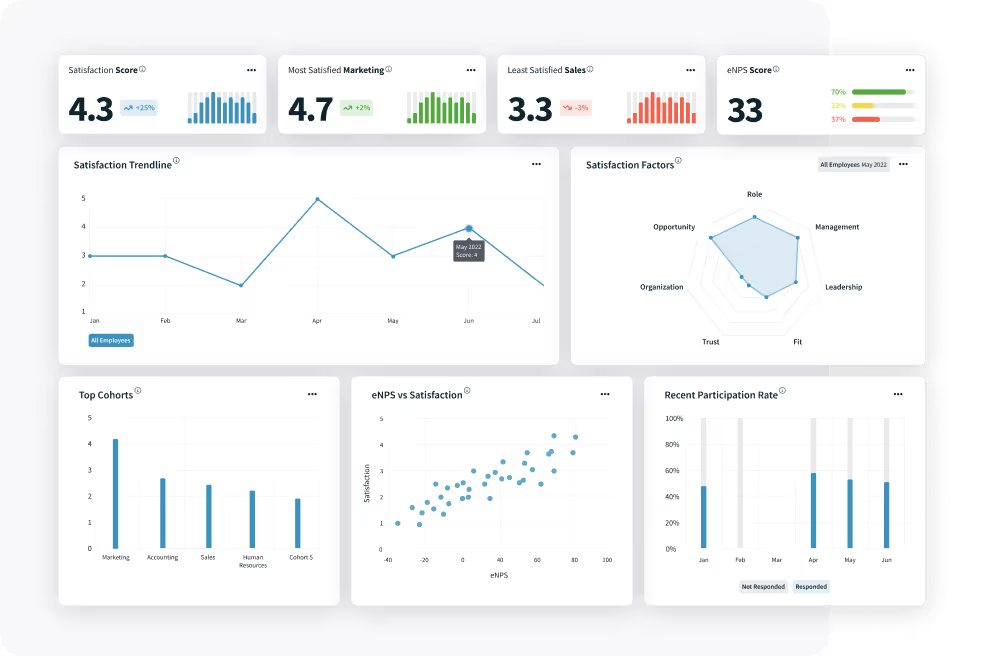How to Calculate Employee Retention Rate in 2025
Employee retention rate measures how well a company keeps its employees over time. It can serve as an indicator of company health and culture. High retention rates indicate a satisfied and engaged workforce, while low rates can signify underlying issues. These could include poor management, inadequate compensation, or lack of growth opportunities.
Employee retention is not just an HR issue. It affects productivity and performance. Additionally, the costs associated with turnover—recruitment, training, and lost productivity—can be staggering. So, improving employee retention is vital for any organization. It helps maintain a competitive edge and a thriving workplace.
This article will discuss factors that influence employee retention and explore strategies to enhance retention.
How to Calculate Employee Retention Rate
The most common formula to calculate employee retention rate is:
Employee Retention Rate = (Number of Employees at End of Period−Number of New Hires) / (Number of Employees at Start of Period) × 100
Here’s a step-by-step breakdown of the calculation:
1. Determine the Period: Decide on the specific period for which you want to calculate the retention rate. Common intervals include monthly, quarterly, or annually.
2. Count the Employees at the Start of the Period: Note the total number of employees at the beginning of the chosen period.
3. Count the Employees at the End of the Period: Note the total number of employees at the end of the chosen period.
4. Count the Number of New Hires: Identify how many new employees were hired during this period.
5. Apply the Formula: Plug and chug the formula to calculate the retention.
For example, if a company started the year with 200 employees, ended with 210, and hired 30 new employees, the calculation would be:
Employee Retention Rate = (210−30) / (200) × 100=90%
This means the company retained 90% of its employees over the year. This is the average retention rate across the US.
Check out this article to learn how to calculate employee turnover rate
Why Is Retention Important?
Understanding the employee retention rate is crucial for any organization. This metric serves as a key indicator of employee satisfaction, workplace culture, and the overall health of the organization. Here are several reasons why knowing the employee retention rate is important:
1. Cost Management: High employee turnover is expensive. Recruitment, training, and onboarding new employees require significant time and resources. By monitoring retention rates, organizations can identify trends and address issues before they result in costly turnover.
2. Workplace Morale: Frequent turnover can disrupt team dynamics, decrease morale, and reduce overall productivity. A stable workforce builds a sense of community. It boosts collaboration and engagement among employees.
3. Productivity and Performance: Experienced employees contribute to higher productivity and better performance. When employees stay longer, they gain expertise and knowledge. This makes them more efficient and effective in their roles.
4. Employee Engagement: Retention rates can reflect the level of employee engagement within an organization. High retention often means high engagement. It shows employees feel valued and motivated to help the company succeed.

5. Strategic Planning: Understanding retention rates helps in strategic workforce planning. It allows organizations to forecast hiring needs, develop succession plans, and create targeted retention strategies to retain top talent.
6. Competitive Advantage: Companies with high retention rates are often viewed as desirable employers. This reputation can attract top talent and provide a competitive advantage in the job market. Employees are more likely to join and stay with a company known for its positive work environment and stability.
7. Identifying Problems: Tracking retention rates can help find issues in the organization. These may include poor management, a lack of career growth, or low pay. Addressing these issues can lead to a more satisfied and committed workforce.
How to Improve Your Employee Retention Rate
Improving employee retention rates requires a multifaceted approach that addresses the various factors contributing to employee satisfaction and commitment. Here are several strategies to enhance retention rates:
-
1. Enhance Onboarding and Training: A good onboarding process helps new employees integrate into the organization. It makes them feel welcomed and prepared. Ongoing training and development opportunities enable employees to acquire new skills and advance their careers, increasing their loyalty to the company.
2. Foster a Positive Workplace Culture: Cultivate an inclusive, supportive, and collaborative work environment. Recognize and celebrate achievements, encourage open communication, and promote work-life balance. A positive workplace culture enhances employee satisfaction and engagement.
3. Offer Competitive Compensation and Benefits: Make sure salaries, bonuses, and benefits are competitive and meet industry standards. Include benefits that matter to employees. Examples include health insurance, retirement plans, and wellness programs.
4. Provide Career Development Opportunities: Create clear career paths and provide opportunities for advancement within the organization. Offer mentorship programs, professional development courses, and opportunities for employees to take on new challenges and responsibilities.
5. Recognize and Reward Performance: Regularly acknowledge and reward employees for their hard work and achievements. Additionally, create a program to recognize and reward top contributions and performances.
6. Improve Management Practices: Effective leadership is crucial for employee retention. Train managers to be supportive, communicative, and responsive to employee needs. Encourage managers to provide regular feedback, set clear expectations, and support their team's professional growth.
7. Gather and Act on Employee Feedback: Conduct regular surveys and feedback sessions to understand employee concerns and suggestions. Act on the feedback received to address issues and improve the workplace environment. Showing that the organization values and responds to employee input can significantly boost morale and retention.
Employee Retention Rates by Industry
To help you benchmark your business against others in your industry, we have researched employee retention rates for the following sectors:
- Retail - Employee retention rates in retail are unfortunately and notoriously low. According to McKinsey & Company, turnover rates for front-line retail employees has been “at least 60 percent for a long time.” The inverse, of course, would be 40% retention. Factors like the lack of workplace flexibility, limited career development, and challenging work environments all contribute to high attrition and low retention.
- Hospitality - Turnover in the U.S. hospitality industry also remains notably high. The Bureau of Labor Statistics reports an annual rate of ~74%. According to Hospitality Net, a lack of ongoing training is a leading cause of high turnover. eHotelier also suggests employee development and engagement are leading factors.
- Nonprofit - Employee turnover rates in the nonprofit industry have fluctuated over the past decade or so. In 2016, a report by GuideStar and Nonprofit HR suggested the rate was 19%. It dropped to 14% in 2020, but has since returned to 19%, as noted by Graham-Pelton.
- Construction - It’s difficult to track down reliable and up-to-date retention statistics in construction. Several articles over the past ~10 years have reported the turnover as high 60%, with differences in employee demographics, company size, and trades all influencing that figure. Meanwhile, the BLS reports an annual job opening rate of 3.5 out of 100, and a total count of openings at roughly 295,000 (as of June 2024).
- Healthcare - According to the NSI National Healthcare Retention & RN Staffing Report, the national turnover rate at hospitals is 20.7% in 2024, a 2.0% decrease from 2022. For nurses, the turnover rate is 18.4%, which was a 4.1% decrease from 2022.
Leveraging Technology
Employee engagement software, such as PerformYard, can help improve employee retention rates by streamlining performance management and fostering employee development.
PerformYard offers a feature-rich system for continuous feedback, goal setting, and performance reviews. It ensures employees receive regular and constructive input. This continuous feedback loop promotes professional growth and satisfaction.
PerformYard also helps to align employee and organization goals. This makes employees feel more connected and valued.
With customizable review processes and comprehensive analytics, managers can surface insights to inform promotions, rewards, and career development opportunities.
Learn more about our employee engagement software or sign up for a free demo.





